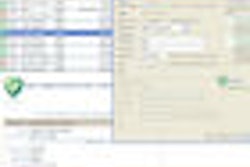A radiology information system (RIS) has the potential to decrease report turnaround time and increase the revenue of a radiology practice, but its impact varies by modality, according to a report published in the October issue of the Journal of the American College of Radiology.
The study analyzed RIS implementation at a large, multifacility radiology practice and found that the software produced greater efficiency overall due to its effects on workflow and improvements in information collection.
For example, the practice increased its productivity level in terms of interpreting mammograms to such an extent that it was able to reduce the number of radiologists reading mammography exams by one, as well as reduce report turnaround time by half. However, the RIS minimally affected MRI exam reporting (JACR, October 2009, Vol. 6:10, pp. 705-714).
In October 2006, Borg Imaging, a network of seven freestanding imaging centers located in and around Rochester, NY, converted from a paper-based radiology workflow to a RIS integrated with a previously installed PACS.
At the time of the transition, Borg Imaging did not undergo any other business-related or IT-related changes, it maintained the same number of personnel (13 radiologists and 140 technologists and support staff), and its average annual volume of 125,000 imaging procedures remained constant. As a result, the radiology practice provided researchers at the William E. Simon Graduate School of Business Administration at the University of Rochester with an ideal opportunity to conduct a pre- and postimplementation comparison.
The research
A research team led by Abraham Seidmann, Ph.D., collected data at four of the seven imaging centers over an 18-month period commencing June 2006. The performance metrics they measured included the duration of appointment scheduling calls, administrative time spent by technologists for each exam, and the percentage of cases where interpretation was delayed due to lack of necessary clinical background information.
The researchers used three metrics to analyze report turnaround time: the time period from completion of an exam to completion of dictation, the time period for transcription, and the time period until approval and sign-off.
The research team collected a pre-RIS data sample throughout the month of June 2006. When the RIS (Kodak Carestream RIS, Carestream Health, Rochester, NY) became operational in October 2006, the team restarted data collection. At the end of February 2007, they determined that RIS utilization patterns had stabilized, and the group collected a post-RIS data sample during the month of March 2007.
The primary objectives of the study were to assess the impact of redesigning a medical imaging workflow using a RIS, to identify changes in information collection, and to measure how report turnaround time might be affected. For the study, the authors compared impact on mammography and MRI exam reporting.
The outcomes
The researchers discovered that the impact of RIS adoption differed based on exam modality and the facility's pre-existing efficiency of clinical information for that procedure. The RIS minimally affected the time it took to schedule, perform, and report MRI exams. However, the impact with respect to mammography brought dramatic improvements.
The research team had originally presumed that a properly configured RIS would require that all necessary information be obtained in a logical order prior to and during a patient's examination, maximizing the radiologist's reading time by ensuring that all information needed for interpretation would be available. They hypothesized that if required clinical information was collected in this manner, more time would be spent by schedulers and technologists, and less time by radiologists, to the financial benefit of the entire practice. They also hypothesized that if the radiologists used report templates, the transcription process would be accelerated.
These hypotheses proved to be correct. However, the more the practice emulated RIS-based information gathering processes when they used paper records, the less impact the RIS had on efficiency improvements following implementation, the researchers discovered.
With respect to MRI exams, the schedulers and technologists had been acquiring all of the clinical information needed when using the paper-based system, and the radiologists used report templates the practice had independently developed. As a result, the time spent performing various tasks related to MRI did not change significantly when the RIS was deployed. It took 45 seconds less per exam for technologists to perform administrative work using the RIS, and report turnaround time for MRI studies went from 3.11 minutes before RIS to 3.20 minutes after RIS implementation.
The information acquisition and management capabilities of the RIS excelled with respect to mammography workflow. With the RIS installed, the schedulers were required to complete all patient-related information fields when they scheduled mammograms, and they could no longer defer the process of obtaining needed information to technologists or the interpreting radiologists themselves.
Although the technologists were required to fully document all examination process-exceptions, such as additional views, retakes, and/or unusual indications, their administrative time dropped from 6.03 to 2.77 minutes per mammography procedure because they were no longer required to copy patient information from one paper form to another.
Because the RIS facilitated access to a patient's medical records, radiology reports, and prior exams, the report turnaround time for mammograms dropped by approximately 50%, from a mean 4.06 hours to 2.17 hours. The percentage of mammography interpretations delayed by missing clinical information dropped from 7.92% to a post-RIS level of 2.56%.
In fact, the RIS enabled the practice to increase its productivity when reading mammograms to the point where 12 radiologists were able to do the work of 13 prior to RIS implementation. The estimated 10% improvement in mammography interpretation productivity was equivalent to a gain of $50,000 per year, per radiologist, according to the authors.
For any examination where the RIS increased the availability of clinically relevant background information at the radiologists' workstations, the number of interpretation delays and workflow interruptions attributed to missing clinical information declined. This increased radiologists' productivity.
Following RIS adoption, and with the requirement to collect all necessary patient data at the point of scheduling, heavier workload requirements were placed on the schedulers. The length of time to schedule a new patient increased from a mean of 3.1 minutes to 4.44 minutes, and length of time increased from 2.49 to 2.73 minutes for an existing patient. Patients who telephoned for appointments were placed on hold for longer periods of time, and the hang-up rate increased from 2.22% to 3.59%.
Increasing the number of schedulers to accommodate for their increased data collection workload and to reduce the wait time for patients would be significantly offset by the potential to increase radiologists' productivity and potentially higher revenue for the practice.
"New information technologies provide significant business value only if they are leveraged to implement effective workflow process innovations," the authors concluded. They noted that the success of leveraging a RIS requires a reorganization of the way in which medical and administrative information is collected, organized, and presented along the radiology workflow. The more inefficient the operations of a paper-based radiology practice, the more cost-effective a RIS has the potential to become.
By Cynthia E. Keen
AuntMinnie.com staff writer
October 7, 2009
Related Reading
PACS drives 70% growth in radiologist productivity, study finds, June 18, 2009
PACS boosts productivity, reporting times, April 24, 2008
Buying a RIS/PACS for a distributed radiology practice requires careful planning, March 31, 2008
RIS/PACS provides potential for performance, safety improvements, March 21, 2007
Copyright © 2009 AuntMinnie.com



















